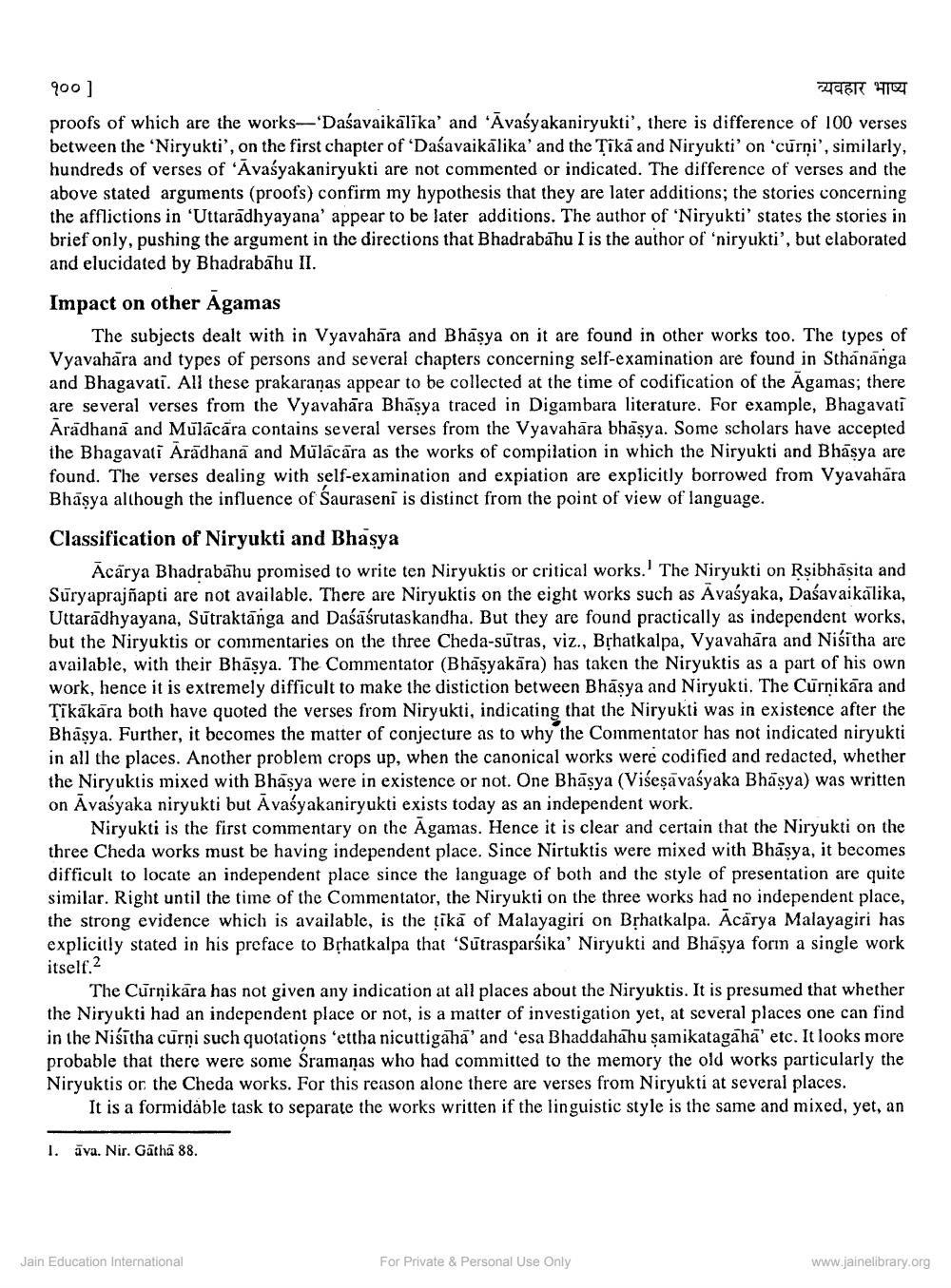________________
१०० ]
व्यवहार भाष्य
proofs of which are the works-Daśavaikalîka' and 'Avaśyakaniryukti", there is difference of 100 verses between the 'Niryukti", on the first chapter of 'Daśavaikālika' and the Ţika and Niryukti' on 'curni', similarly, hundreds of verses of 'Avaśyakaniryukti are not commented or indicated. The difference of verses and the above stated arguments (proofs) confirm my hypothesis that they are later additions; the stories concerning the afflictions in 'Uttaradhyayana' appear to be later additions. The author of 'Niryukti' states the stories in brief only, pushing the argument in the directions that Bhadrabahu I is the author of 'niryukti", but elaborated and elucidated by Bhadrabahu II.
Impact on other Agamas
The subjects dealt with in Vyavahara and Bhasya on it are found in other works too. The types of Vyavahara and types of persons and several chapters concerning self-examination are found in Sthananga and Bhagavati. All these prakaranas appear to be collected at the time of codification of the Agamas; there are several verses from the Vyavahara Bhasya traced in Digambara literature. For example, Bhagavati Aradhana and Mulácara contains several verses from the Vyavahāra bhäṣya. Some scholars have accepted the Bhagavati Aradhana and Mulácara as the works of compilation in which the Niryukti and Bhasya are found. The verses dealing with self-examination and expiation are explicitly borrowed from Vyavahāra Bhasya although the influence of Sauraseni is distinct from the point of view of language.
Classification of Niryukti and Bhasya
Acarya Bhadrabahu promised to write ten Niryuktis or critical works. The Niryukti on Rṣibhāṣita and Suryaprajñapti are not available. There are Niryuktis on the eight works such as Avaśyaka, Daśavaikālika, Uttaradhyayana, Sutraktanga and Daśāśrutaskandha. But they are found practically as independent works. but the Niryuktis or commentaries on the three Cheda-sutras, viz., Bṛhatkalpa, Vyavahara and Niśitha are available, with their Bhasya. The Commentator (Bhasyakara) has taken the Niryuktis as a part of his own work, hence it is extremely difficult to make the distiction between Bhasya and Niryukti. The Curṇikara and Tīkākāra both have quoted the verses from Niryukti, indicating that the Niryukti was in existence after the Bhasya. Further, it becomes the matter of conjecture as to why the Commentator has not indicated niryukti in all the places. Another problem crops up, when the canonical works were codified and redacted, whether the Niryuktis mixed with Bhasya were in existence or not. One Bhasya (Viśeşävaśyaka Bhāṣya) was written on Avasyaka niryukti but Avaśyakaniryukti exists today as an independent work.
Niryukti is the first commentary on the Agamas. Hence it is clear and certain that the Niryukti on the three Cheda works must be having independent place. Since Nirtuktis were mixed with Bhaṣya, it becomes difficult to locate an independent place since the language of both and the style of presentation are quite similar. Right until the time of the Commentator, the Niryukti on the three works had no independent place, the strong evidence which is available, is the lika of Malayagiri on Bṛhatkalpa. Acarya Malayagiri has explicitly stated in his preface to Bhatkalpa that 'Sutrasparśika' Niryukti and Bhasya form a single work itself.2
The Curnikara has not given any indication at all places about the Niryuktis. It is presumed that whether the Niryukti had an independent place or not, is a matter of investigation yet, at several places one can find in the Niśitha curni such quotations 'ettha nicuttigaha' and 'esa Bhaddahahu şamikatagaha' etc. It looks more probable that there were some Śramanas who had committed to the memory the old works particularly the Niryuktis or the Cheda works. For this reason alone there are verses from Niryukti at several places.
It is a formidable task to separate the works written if the linguistic style is the same and mixed, yet, an
1. ava. Nir. Gatha 88.
Jain Education International
For Private & Personal Use Only
www.jainelibrary.org




